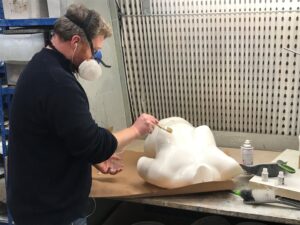Groningen install a solar pavement which will power the city hall
As one of the two lighthouse cities in the MAKING CITY project, Groningen in the Netherlands has been seeing more than its fair share of innovation recently and the latest of these is the installation of a solar pavement.
MAKING CITY is a 60-month project which was launched in December 2018, aiming to ‘address and demonstrate the urban energy system transformation towards smart and low-carbon cities, based on the Positive Energy District (PED) concept’.

PEDs are energy efficient districts that have net zero carbon dioxide emissions and work towards an annual local
surplus production of renewable energy. The PED implementation in Groningen involves the retrofitting of residential buildings (floors, roofs, fronts, windows, smart thermostats and sensors to real-time measuring of energy consumption) in order to maximise infrastructure performance.
Four demonstration houses – all built during different eras – have been retrofitted and made energy neutral.
Solar panels are being installed on the roofs of some buildings and car parks and solar thermal panels will support geothermal heat pumps which are directly connected to the geothermal district heating system. The surplus of thermal energy produced by some residential buildings will be stored and used during energy demand peaks.
The latest innovation in the city is a 400m2 solar pavement created using 2,544 solar pavers that produces approximately 53,000 kWh of electricity per year. The energy produced here is used to power the municipality’s city hall, making the building more sustainable.
Philip Broeksma, Council of Energy from the Municipality of Groningen, said: ‘This innovative solar footpath contributes to the city’s ambition of becoming CO2 neutral by 2035. The solar pavers are doubly sustainable because they not only provide green energy but are made of recycled plastic. And it makes double use of space: the solar footpath generates electricity, while people can simply and safely walk on it. It is an example of how to use space in the city in a smart and sustainable way’.
András Sebők, the CEO of PLATIO Solar whose technology is being used here said: ‘The installation has a projected yearly production volume of 53 000 KW and offsets approximately 18 tons of CO2. The product itself is a net-zero building material. Now, this solar path powers a public building, but communities can use this technology for other uses as well, as it can power buildings and any outdoor utensils as well. We appreciate the opportunity to be integrated into the Making City project, we do hope this installation will fulfill and tackle the climate-neutral goals of Groningen’
Theo Hoek from Bengsolar, the Dutch reseller of PLATIO who installed the pavement added: ‘This energy production equals 18 average Dutch households’ yearly energy needs.’
Monitoring the system’s performance on an app, Theo pulled out his phone to reveal that the energy production so far that day could power 47 houses for 24 hours.
















